#KIMONO 2014
Explore tagged Tumblr posts
Text

THE ART OF RED LIGHT PHOTOGRAPHY -- ICELANDIC MUSIC MEETS AN EXPERIMENTAL MUSIC LEGEND.
PIC INFO: Spotlight on the late, great Damo Suzuki, formerly of experimental rock band CAN, performing live with the Icelandic rock trio KIMONO, at Faktorÿ in Reykjavík, Iceland, c. 2014. 📸: @benedikt_reynisson of @skatar_official.
Source: www.picuki.com/media/3432391996789053771.
#KIMONO band#KIMONO from Iceland#2014#Rock Music#Indie rock#Punk rock#Iceland#Post punk#Post-punk#Alternative rock#Post-rock#Damo Suzuki#Icelandic rock#Icelandic band#Photography#Red Light#Reykjavik Iceland#Reykjavik#Neon Light#Rock Trio#Guitar rock#KIMONO 2014#Iceland Music#Krautrock#Rock Vocalist#Rock Singer#Vocalist#Experimental rock#Experimental Music
2 notes
·
View notes
Text
everyone reblog/reply with your favourite figure you got in 2023! <3
#i got so many of my favs this year oh i can't possibly choose#i got the michael myers and beetlejuice and ash williams and edward scissorhands bishoujo figs by kotobukiya#and the 2014 1/8 gsc racing miku and the heart hunter 1/7 miku by max factor#and the 1/8 original character night hag lilith by myethos and the 1/8 angel beats kanade gsc of her in a kimono with her wings#well obviously i can't choose but i'll tell you my least favourite. that piece of shit chainsaw man denji estream 1/7 figure#paid a fucking fortune for it and i hate it. anyway#excited to see yoy guys' favs!!!!!!#me.txt#non figure
95 notes
·
View notes
Text
Sparks & The Heritage Orchestra - Amateur Hour (december 19 2014)
10 years ago today! To celebrate I have finally uploaded my recordings on YouTube, you can find them all here.
Kimono My House Overture
This Town Ain't Big Enough For Both Of Us
Amateur Hour
Falling In Love With Myself Again
Here In Heaven
Thank God It's Not Christmas
Hasta Mañana, Monsieur
Talent Is An Asset
Complaints
In My Family
Equator & applause
Part 2:
The Rhythm Thief
Get In The Swing
Let The Monkey Drive
Looks, Looks, Looks
Pulling Rabbits Out Of A Hat
Excerpts from The Seduction Of Ingmar Bergman
Dick Around
When Do I Get To Sing "My Way"
The Number One Song In Heaven
Encore:
Change
#russell mael#ron mael#sparks (band)#sparks#kimono my house#amateur hour#kmh#december 19 2014#2014#10's#...I recorded almost the entire show because I'd had a concussion earlier that year and worried my memory might screw me over#upside is that it now still all exists! 💖
16 notes
·
View notes
Text

There this fic that is very old and a classic in the sesskag fandom, I didn’t even remember I downloaded it by a page that is already dead so I give it a cover that was well deserve, maybe at vacaction in the university I reread it.
#kagome and sesshomaru#sesskag#sesskag fic#Cover#fic cover#it was awful look for a good imagen of a kid in male kimono where is can be use as a ambiguous because sesshomaru white hair but manage it#Still a good fic#My kindle didn’t understand colors but is still okay because the fic deserve a good cover so is can be recognized in future#Is a 2009-2010 fic right? How this fic and author survive the 2014 purge of fanfiction I don’t know but they survive#Forthright now today days make youkai/monsters romance book that she sell and are as good as the fic#Now I will never forgot this fic in my kindle because the cover will let me know
4 notes
·
View notes
Text
From a thing to wear to an icon of culture 👘

There is this hidden detail in Muzan that when I noticed I could not help but smile. Remember how he said that the thing he hated the most was change? Well coming from someone that had to live in 5 different eras is kinda funny, and it's even funny when you realize that he ended up adopting the Western fashion pretty fast. But that's the twist, if you look at Muzan's vest you come to realize that it's the exact same pattern as the kimono he used to wear. The best part? That was a thing that actually happened in history.
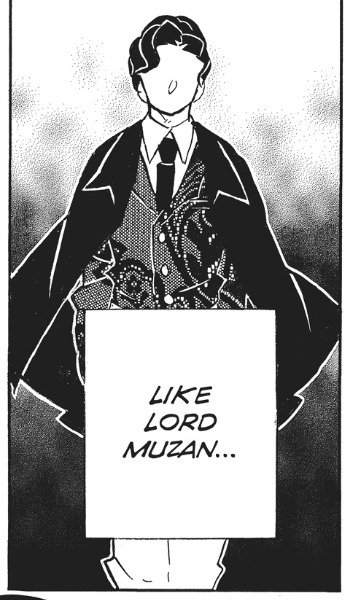
Wanting or not, the clothing that the people used to wear represents the history they lived through. "To look seriously at art objects of the everyday, such as clothes - their discourse and practices, their meaning-bearing forms and their codes of internal and external interpretations - in an essential, and often neglected, component of any study of modern aesthetics." - Slade, 2009 Yofuku [Western Clothing] is a type of clothing that is now common all over Japan, but during a lot of time, it was a type of clothes that only selected few grew up with. The 1st contacts with these types of clothing [even if extremely different from what we now call western clothing] was in the 16th century when the Portuguese arrived in Tanegashima. With them came not only different shapes but also different fabrics. But the “true” introduction to western fashion would only happen with Commodore Matthew Perry, catharsis to the Meiji restoration, where Emperor Meiji would start to dress in a typical western military outfit, and soon after the empress would start to aper in the typical victorian dresses. In the Edo period clothing visually distinguished the social classes. "Certain articles of clothing visibly differentiated people of diverse social classes, and simultaneously distinguished an individual within a specific group. The materials, motifs and construction of military campaign coats, for example, marked their wearers as men belonging to the military class." - Milhaupt, 2014; Samurai ranked on the top, followed by farmers, artisans, and merchants on the bottom. What happen was that most of the times the samurai where poor while the merchants lived in economic success. But samurai had the privilege of using certain types of fabrics and patters, even tho most of the times they could not afford them, and so, the merchants would start to adapt the fabrics and patters they were allowed to were and would end up becoming the patrons of arts and fashion. The trends of fashion would later be documented in ukiyo-e, and not only in the work of art sense, but also in pattern books were people could browse the prevailing styles. After the 1st contacts with the westerners, what would start to happen is that slowly but surely the Japanese would start to integrate the western ways of dressing into their lives. The Japanese started to introduce some of its elements with the kimono, shoes, hats, gloves, glasses, umbrellas, etc. Then in the 19th century a full change would happen starting from the man in the highest classes to the man in the lowest classes. The emperor decided to cut his topknot in 1872 and started to dress in western clothing in official appearances, also changing some of the more cultural habits like eating meat and more wester kind of meals. In the official portraits he appears adorned with a French-style military uniform with ornaments in gold and ostrich feathers. Before this, the emperor was never a public figure, so when pictures of the Meiji Emperor became available, and he started to appear more publicly the nation would have their eyes on him and start to imitate him. Women would, for the longest time still dress in the now classic kimono, that would develop as a symbol of the old and traditional Japan. The idea of the western clothing being associated with a modernized Japan and the Kimono [that literally means “thing to wear”] to a traditional country came from the fact that the emperor would choose to wear western clothes in more formal, international events, and for religious national events would choose the traditional Japanese court dress. The western clothes will end up being a symbol of the modernization of Japan, and the Meiji government would use it as yet another tool of national control. For all the Japanese born after 1945 the western clothes became the norm. Most families would end up transforming their kimonos into western clothing pieces, and the patterns sold for kimonos would double for kimonos and western clothing.
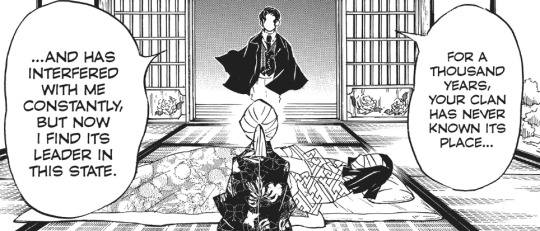
But it is funny to notice how despite it all Muzan is the one being presented in western clothing and Ubuyashiki is the one in traditional clothes, always being the contradiction of the other, but also it can also be interpretated as the Ubuyashibi family being "trapped" in the past since in hundred years the corps never killed an upper moon, the history never changed. And Muzan in his ever-changing cycle of his life, in the changing of eras and changing of personas he decided to reuse the only thing he could: his clothes. And just like him, they would adapt through the times.

MILHAUPT, Terry Satsuki. 2014 - Kimono: A Modern History. London: Reaktion Books [Ebook]; SLADE, Toby. 2009 - Japanese Fashion: A cultural History. Oxford, Berg. [Ebook];
#demon slayer#history#demon slayer from history to fantasy#demonslayerfromhistorytofantasy#history research#japanese history#demon slayer history#kimetsu no yaiba#research#demon slayer muzan#muzan kibutsuji#ubuyashiki#kimono
234 notes
·
View notes
Text

Nora Akino(Japanese/American)
Kimono Moon 2014 monotype 15″x21″ via
106 notes
·
View notes
Text
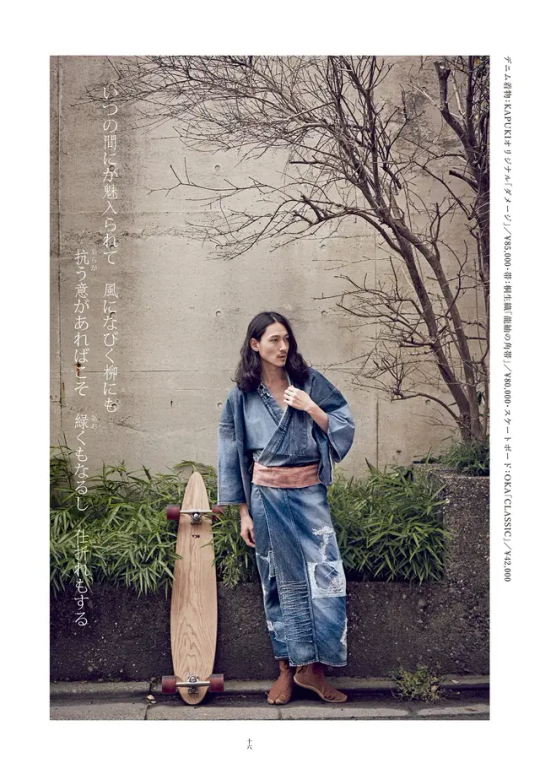
Tou Katsu in an editorial for Kapuki denim kimonos. (2014)
67 notes
·
View notes
Text
Does anyone know what's up with the "2014 aesthetic" thing? I keep seeing these moodboards that are, apparently, meant to be pictures that look like 2014, but they're like images of eos eggs, TOMS, kimonos, and hoards of victoria secret body spray. In case yall did not know, eos eggs were not cool anymore in 2014
50 notes
·
View notes
Note
Hello ! I really admire your blog and knowledge , I want to start by saying thank you for your hard work and dedication ! I would like to ask , what’s the difference between saying 〜をどり and 〜おどり ? I assume they must be read the same , but is it a difference of dialects , type of event , etc. ? If you don’t mind me putting another question there and if it isn’t too personal , what made you create this blog and start diving into this world ?
Hello! I'm glad if you can learn something new with this blog :) As far as I know, yes - をどり and おどり are read the same, but the spelling with "を" is older and likely used to make the "odori" look more traditional. Don't think it is related to dialects or different events. What made me create this blog and start diving into this world? Some time in 2010, I was hanging around on tumblr, followed some Japan-related blogs and came across this picture:

Although I knew about the existance of Geisha in general before (misconceptions mostly), this specific picture was the start of a deeper interest. It was all super fascinating. The colours, the kimono, the seasonal changes... so, a Maiko from Kyoto was the gateway drug for me, as for many other people too :D In December 2012, I was still very confused about everything and joined Tsurukomaiko forums (back then, they were partially open to public). There, I came across the fact that there's Geisha outside of Kyoto too and found it even more confusing. But tbh, there were still a lot of misconceptions like "she wears a wig? Can't be a real Maiko. She wears Furisode, not Hikizuri? Can't be a real Maiko. And what's this weird Obi knot?" (a more advanced challenge was "is she a Furisode-san or an Asakusa Hangyoku?"). The topic of "Geisha outside of Kyoto" didn't let me go, and I learned more and more (over the years, there was more info available on the internet, compared to 2008, when Tsurukomaiko forums started, and 2014, when I actively started collecting pictures and searching for infos. This blog was started in 2016 to share my growing hobby of "Geisha outside of Kyoto" with other people who might be interested in it, and there's still so much to discover! That's it :)
22 notes
·
View notes
Note
heyy^^ sorry to bother I just wanted to ask is your pfp official art?? if so where did you find it?
not a bother at all!!! My pfp is official art from the anime in 2014, some rare posters. It comes in a box set with the popular image of kiyotaka, mondo, and yasuhiro in Kimonos. The image of my pfp is of Leon in a byakuya outfit, he's with Makoto and Byakuya. The original image has a big sample text over the top. I'll try and find the original image and reblog it later (I have the image on laptop rn but I'm on phone). Search up "#Leon Kuwata" on my tags if you want to find it quickly!! <3<3<3
5 notes
·
View notes
Text

Omega Radio for February 24, 2014; #47.
Laura Nyro “Buy And Sell”
Tim Weisberg “Killing Me Softly With His Song”
Smoke “Shelda”
Gianni Oddi “Kimono Pop”
William B. Tanner “The Cat”
Jacky Giordano “Train”
Puccio Roelens “Northern Lights”
Blue Mitchell “Delilah”
Phil Upchurch & Tennyson Stephens “South Side Morning”
Eddie Harris & Les McCann “Set Us Free”
Joe Simon “It Be’s That Way Sometimes”
Rance Allen Group “Give My All To You”
Exuma “Silver City”
Orchestra Julian “Do It With Class”
Modern Soul Band “5 Hach Nalb 7”
Eddie Bo & Inez Cheatham “Lover And A Friend”
Black Sugar “Kathy”
Lalo Schiffrin & The Mike Curb Congregation “Burning Bridges”
Blackrock “Yeah Yeah”
Bayete “Free Angela (Thoughts…And All I Got To Say)”
Michael De Albuquerque “Sweet Mirth”
Gladys McFadden & The Loving Sisters “Never Gonna Turn Around”
Jeannie Reynolds “I’m Hooked On You”
Riff Raff “Original Man”
General Lee & The Space Army Band “We Did It Baby” part 1 & 2
John Tropea “Can’t Hide Love”
Teddy Lasry “Los Angeles”
Gil Flat “End Of A Story” part 2
Leroy Vinnegar “Doing That Thing"
Modern Sound Quartet “Eerie Night”
Pierre Arvay “Sky Way”
Rubba “Way Star”
Guru Guru “Taoma”
Bill Summers “Brazilian Skies”
George Duke “Feel”
Herbie Hancock “Spiraling Prism”
Tony Hymas “Final Inspection”
Azymuth “Fly Over The Horizon (Vôo Sobre O Horizonte)”
Bonus broadcast of vinyl treasures, sampling, crate-digging, soul, funk, groove, R&B, jazz, and fusion.
#omega#music#playlists#mixtapes#vinyl#sampling#crate-digging#funk#soul#groove#R&B#jazz#fusion#Azymuth#Herbie Hancock#George Duke#Bill Summers#Phil Upchurch#Laura Nyro
7 notes
·
View notes
Note
Helllooo I would love it if you could find some lovely green kimonos to post ❤️❤️ I feel like green is an underappreciated color on kimonos!
Green is actually quite present in Japanese traditional color palette! Kimono fashion uses many green hues from deep jewel ones (mostly for winter), to light and soft ones (reminding people of young spring sprouts).
I rarely tag colors, but you can check the blog archives page which will let you see all past notes since blog creation in January 2014 ;)
29 notes
·
View notes
Text
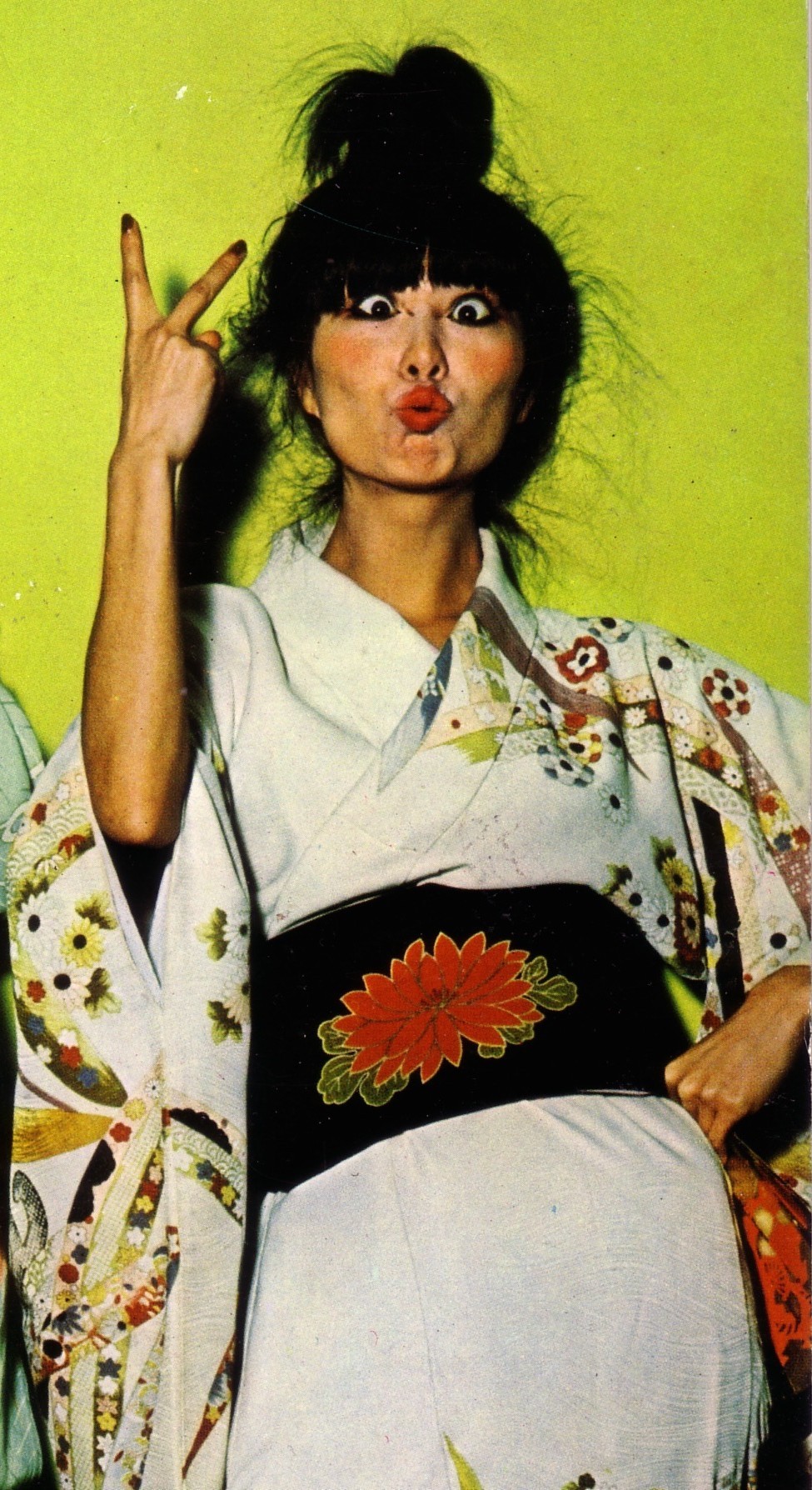
"IS THERE A GEISHA IN THE HOUSE?" -- IN MICHI HIROTA'S OWN WORDS.
NOTE: I cropped the hell out of this "Kimono My House" outtake and am currently using it as my cellphone wallpaper. Michi is such fun to look at!
MADELINE BOCARO: "What led you to become a model on the cover of "Kimono My House"?"
MICHI: "We were both actresses touring with a Japanese theatre company in Europe and the USA. My husband Joji Hirota was musical director. A record company (Island records) approached our director looking for Japanese women, and we were asked to do the modeling. I am the woman on the right (with a fan)."
MADELINE: "Do you know the whereabouts of the geisha on the left?"
MICHI: "I have no news about the other lady since I left the Japanese theatre company at that time, however her maiden name was Kuniko Okamura. She married a Frenchman soon after finishing our tour and bore 4 children."
MB: "What kind of instructions did Ron Mael, or the photographer give you?"
MH: "We were not told much, they just let us move freely. We didn’t know how to arrange our hair properly or how to fix our kimono. There was nobody to dress us. The session took 4 or 5 hours."
MB: "Karl Stoecker also photographed models for the ROXY MUSIC album covers. Did you ever work with him again?"
MH: "I’ve heard that he is the one of the foremost photographers in the world, but unfortunately I never had a chance to work with him. (I would like to, if he is looking for an old Japanese lady!)"
Source: https://madelinex.com/2014/12/25/sparks-iconic-album-cover-kimono-my-house.
#SPARKS#SPARKS band#Michi Hirota#Hirota Michi#Kimono My House#1970s#Kimono My House 1974#Karl Stoecker#Photography#Glam rock#70s fashion#Japanese Dance Company#Sleeve Art#Red Buddha Theatre#Hair and Makeup#SPARKS Kimono My House 1974#Photoshoot#Photosession#Super Seventies#1974#SPARKS 1974#Vintage Style#Glam#70s#Japanese#Geisha fashion#Avant-pop#Art rock#Geisha#SPARKS Kimono My House
31 notes
·
View notes
Text
Wrestling Love Letters
Intrigue and Mastery: A Traditional Japanese Villain Emerges

Shinsuke Nakamura, the former three-time IWGP Heavyweight Champion, a man who's won the prestigious 2011 G1 Climax and the 2014 New Japan Cup, was also the founding member of the stable 'Chaos' (currently led by Kazuchika Okada), cemented his status as a true wrestling icon long ago. The King of Strong Style's journey through the world of professional wrestling has been nothing short of remarkable but, up until recently, he's been cruising along living the 'future hall of famer' life.
Shinsuke has always been able to capture the hearts of fans with his charismatic presence. Whether it's his infectious smile, his captivating entrance music that gets the crowd singing, or his unique in-ring style, Nakamura has always been a fan favourite. However, in recent times, it felt like something was missing. It seemed as though we hadn't seen a certain side of Shinsuke, and he was merely showing up to give us his best professional babyface performance without being a viable contender for a title or someone we eagerly anticipated seeing at the top of the card.
A contributing factor to this feeling was WWE's insistence on having Nakamura communicate primarily in English, limiting his ability to cut compelling promos. Despite this, he compensated adeptly with his eccentric and exaggerated facial expressions, which effectively conveyed his emotions when the scripts fell short. This issue isn't unique to Nakamura; it extends to other Japanese wrestlers, including Asuka and Iyo Sky, who also both occupy prominent positions on the roster and the women's title scene.
Then came the game-changing moment - Nakamura's heel turn on Monday Night Raw (August 7th, 2023) and subsequent promo the following week. The promo involved a clever twist: Nakamura initially speaking in English, pausing to contemplate his next words, only to dismiss the need for understanding from the crowd or his opponent and seamlessly transitioning to Japanese. It was as if the man brimming with charm had unearthed an entirely new reservoir of charisma.
For someone who has tried and failed to learn Japanese, witnessing Nakamura speak his native language with such animation was truly enchanting. It was as if he'd finally been allowed to show his true self and was running with that opportunity. His animated facial expressions, body language and impassioned delivery made it almost feel as though you comprehended his words, even if you couldn't speak a word of Japanese. This change demonstrated that the WWE audience don't always require spoon-fed storylines to grasp a narrative.
Shinsuke complimented his change in character with a slight tweak in his appearance, now wearing dark kimono-inspired outfits, evoking the classic Japanese villain archetype. This archetype typically pits the villain against a heroic protagonist, in this case, the baby face Seth Rollins. The hero-villain dynamic, central to many Japanese narratives like samurai epics and martial arts tales, usually unfolds with the villain displaying a complex relationship with the concept of honour and quite often they themselves were once a beloved hero. I initially questioned why it had taken so long for WWE to pull the trigger on this heel turn but soon realised that it may not have been as effective if acted on sooner.
Nakamura's decision to whisper a cryptic threat to Seth Rollins was a genius move to get the audience speculating what could have possibly been said (a wrestling storytelling technique reminiscent of Undertaker whispering to Bray Wyatt). And later revealing his knowledge of Seth's persistent back issues, ignited their feud brilliantly and played into the traditional Japanese villain traits of intelligence, cunning and manipulation. Following Payback 2023, the challenge was maintaining the momentum of this rivalry. Nakamura, adopting the quintessential villain role, goaded Seth to the point of Seth demanding a rematch, only for Nakamura to deny his request until he deemed the time is right. The calculated manipulation, marked by meticulous planning and tactics, exemplifies Nakamura's mastery of this character.
I'm confident I'm not alone in backing Shinsuke in this ongoing feud with Seth Rollins, I would love to see him have a heel run with the title, orchestrating the fate of the baby faces on the roster like a master puppeteer. While Rollins is a safe pair of hands, I'd like to see him drop down the card and confront the challenge of having to claw his way back up. This journey could infuse his character with a newfound intensity, potentially sowing the seed for a compelling character transformation. Nakamura has undoubtedly regained his cool factor, and it's high time for WWE to capitalise on this resurgence and explore fresh storytelling avenues.
With pins, submissions, and a whole lot of heart, Chloe xoxo
13.09.2023
#shinsuke nakamura#shinsuke#nakamura#seth rollins#wwe fandom#wweuniverse#wwe raw#wwe title#pro wrestling#pro wrestlers#japanese wrestling#heroes and villains#heel turn
10 notes
·
View notes
Text
ADEKUNLE GOLD IS CONSTANTLY EVOLVING
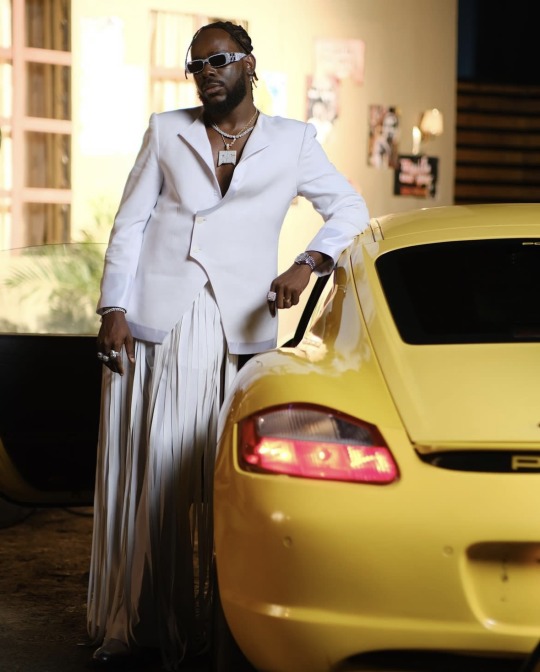
Adekunle Gold, the Lagos-born prolific singer, is one of the handful of Nigerian artists who can boast of a lasting presence in the highly competitive space that is the country's music industry. His was a journey of talent, consistency, invention and reinvention.
He was born Adekunle Kosoko, a member of the royal Kosoko family of Lagos Island, so when he chose to follow his passion in music, the name Gold readily appealed to him. Days spent riding to school with his father while they played Ebenezer Obey and King Sunny Ade, as well as lullabies sung by his aunt at bedtime, planted a love for music in the young Adekunle. With time, his love for listening to music spurred him to create his own. Like many other budding artists, he cultivated his talents first by joining the junior choir in his church and later, by forming a band with a close friend, Michael Bakare, before deciding to pursue a career as a solo artist. Michael remains a major musical pillar of Adekunle Gold’s career, his songwriting and production credits can be found as recently as Adekunle's latest album.
Nigeria's first introduction to the artist, however, was through his creative work as a photo editor. Prior to the release of “Sade” in December 2015, Gold had been given the title of 'King of Photoshop' for his creative editing of his images on pictures of actress Tonto Dike, OAP, Toolz and especially afrobeats queen, Tiwa Savage. A young Adekunle Gold had finished school with a diploma in Arts and Industrial Design and was putting his degree to good use, doing graphic design work for a number of YBNL artists, including Viktoh, Lil Kesh and even street-pop legend Olamide.
In 2014, Adekunle Gold released “Sade”, a cover of One direction's “Story of my Life”, and based upon a real life Sade who had turned his affections down. As the song gained ground, Pheelz, YBNL's in-house producer, saw there was more To Adekunle Gold's creativity than visual arts, and after conversations with label huncho, Olamide, Adekunle Gold was unveiled as a YBNL artist in March 2015. Then, he got a chance at a proper debut single, and "Orente" was born; a folksy Yoruba-supported love ballad, featuring distinct Yoruba instrumentation, which would grow to become his signature style. He followed this up with “Pick up”, which amped up production for a Juju-influenced song that would be an excellent fit for a live band.
All these built up to the release of his first studio album in July 2016, Gold that featured successes such as "Work", "Ariwo Ko", and another all time classic, "No forget", a duet with Simi, a friend and fellow artist who had previously mixed and mastered songs for him. His debut album was a critically acclaimed success, peaking at no. 7 on the Billboard World Album Chart.
His next studio album, About 30, was released in 2018 after exchanging amicable farewells with YBNL. He assembled a team of instrumentalists into a live band, named the 79th Element (Gold), and headed by Michael Bakare. As a result the album drew chiefly from his unique upbeat trad-style music which he christened Urban Highlife, and it housed a number of memorable songs like the energetic "Money", the evocative "Ire" and the sombre "Fame".
Until 2019 Adekunle Gold had operated firmly within the boundaries of his self-styled Afro Urban genre, where live instruments could meet with intoned delivery to channel some of the essence of Yoruba Juju music in a more modern setting. For the next step, though, it was time for an artistic refresh, and to achieve it, he will have to sacrifice some of his folksy essence for better mainstream appeal. And so he braided his boyish afro into a macho cornrow, while he discarded the Adire shirts for brightly coloured jackets and flowing kimonos, left unbuttoned to show his new buff physique, completing his look with tinted glasses and loose fitting pants. His switch in music was a lot less acute. For "Before You Wake Up", his first solo single of 2019, he maintained a similar delivery but production was different, employing more studio-made Afrobeats rather than the live drums and keys he was more popular with. Also subtle was his use of English and Pidgin for the entirety of the single, in the past Adekunle Gold had relied chiefly on Yoruba.
It was in 2020 that he properly donned the artistic personality he would take for his next era. First came "Jore", a duet with Kizz Daniel that leaned into Kizz's brand of casual afropop that was backed by catchy lyrics and a flowing beat. Then he released "Something Different", which was as it was named, a continual of the sonic detour he was making towards the mainstream. In mid 2020, “AG Baby" was released, the manifesto for his artistic vision; on the track he alludes to being the "street boy popping on the mainstream shit". “AG Baby’ was homonymous with his new persona, and on his next album, “Afro-Pop Vol. 1”, he delved properly into who he was now and what to expect of him. A song like “Okay” handled this orientation nicely, as he spun the mid-tempo pop groove into a song deriding his haters.
While AG Baby was morphing into the popstar, Adekunle Gold was settling into family life. His marriage to Simi was for many a bolt from the blue, but insiders into the couple’s lives knew they had been an item even before either of them made their debuts in the industry. Simi had produced, as well as mixed and mastered a chunk of Adekunle Gold’s Gold album, and Adekunle has gone on record to credit her with helping him find his music style. The pair had collaborated across a number of tracks over the years, each time bringing amazing chemistry that most fans did not know was the product of real life love they shared. On January 17th they released “Promise”, a tribute to their new union and the first official announcement of it. A little over a year later, in May 2021, “Happy Birthday”was released; a love letter to their daughter, Adejare on her first birthday.
2021 also saw him release three successful singles that would appear on his next album, “Catch me if You Can”, “Sinner” and “It Is What It Is” followed the laid back, less-is-more delivery of his newly perfected style. But “High”, featuring industry heavyweight Davido, was a different dish altogether; an Amapiano heavy hit, foreshadowing another shedding, or perhaps more accurately, an extra layering of personality that would lead AG Baby to give way to Tio Tequila. The lover boy Adekunle who had withstood the transition from Adekunle Gold to AG Baby evolved to another man for whom “Love is not enough”.
His latest project, Tequila Ever After, is named after this new persona, and here he slows down his Afropop cadences to take in parts of Dancehall and RnB. By far his biggest project, Adekunle Gold assembled RnB megastars like Pharrell Williams and Khalid as well as budding Nigerian street stars like Zinoleesky and Odumodublvck. He has already hit the charts with two singles, “Ogaranya” and “Party No Dey Stop”, so he will be hopeful others can quickly follow suit. More importantly, though, he will hope his new project, and the persona he introduces with it, can significantly advance his global intentions. Adekunle Gold has described his latest project as a celebration of his wins so far.
With a solid discography encompassing five successful projects, a recently bagged contract with an international label in Def Jam Records and a career about to reach the 10 year mark, a celebration is much needed and well deserved. As the artist readies himself to consolidate his position in the Nigerian market and expand his wings even further beyond the shores of the country, he can take a shot of Tequila and toast to his wins so far, because it only gets better from here.
This article was written by Afrobeats City Contributor Ezema Patrick - @ezemapatrick (Twitter)
Afrobeats City doesn’t own the right to the images - image source: Instagram - @Adekunlegold
#Afrobeats#AfrobeatsCity#Adekunle Gold#Africa#African music#Afropop#Afrobeats article#Article#Music#Nigeria#Nigerian music#Def Jam#Tequila ever after
8 notes
·
View notes
Text
Gas station clone dolls
On a dark desert highway in Mojave, there's a Kwik Stop with a small section of clone dolls.
I present, for your delectation, Jada.
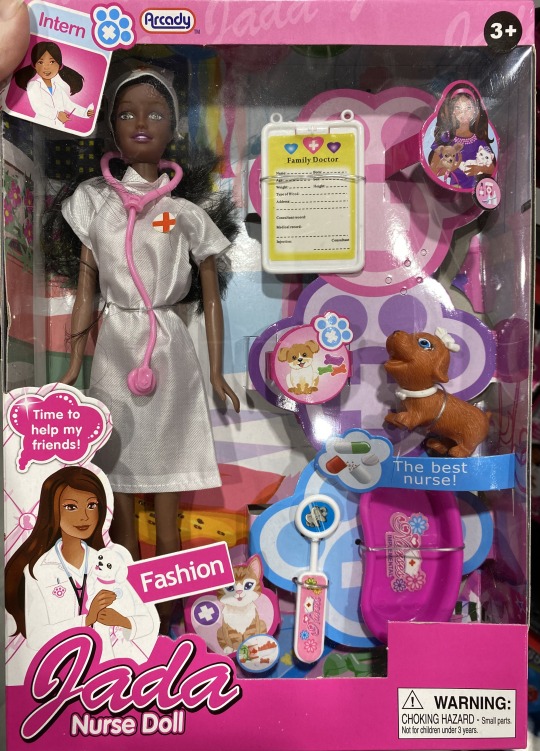
While Jada is labeled Nurse Doll, she appears from her accoutrements to be a veterinarian. She has the same dog as Emily, Girl and Her Pets, who also comes with a rolling suitcase. (As is often the case with low-end clones, Jada has a healthier looking face-up than white Emily.)
Jada and Emily are imported by Artoy Trading LLC, impulse toys, joy in every toy!
I didn't check for the importer on Chloe, The Ultimate Fashionista! because I was so struck by how she has the face of a 2014-ish Dollar Tree Beauty. It's been a while since I've seen that specific face-up.
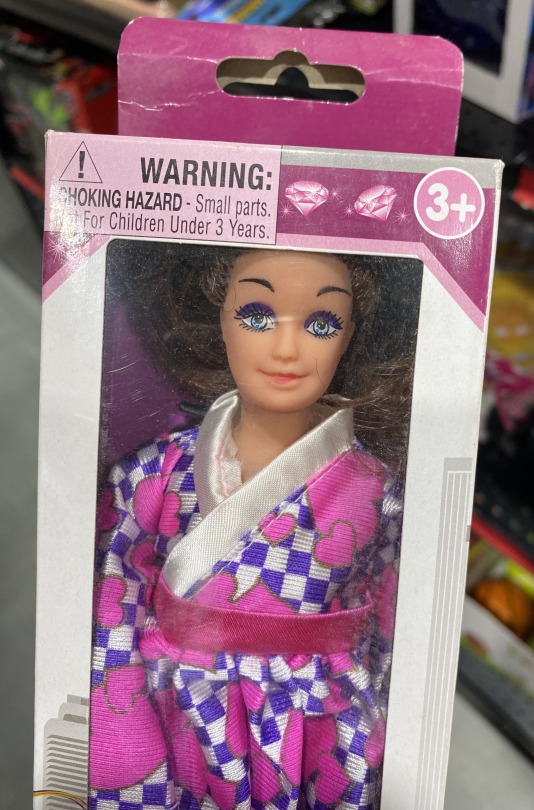
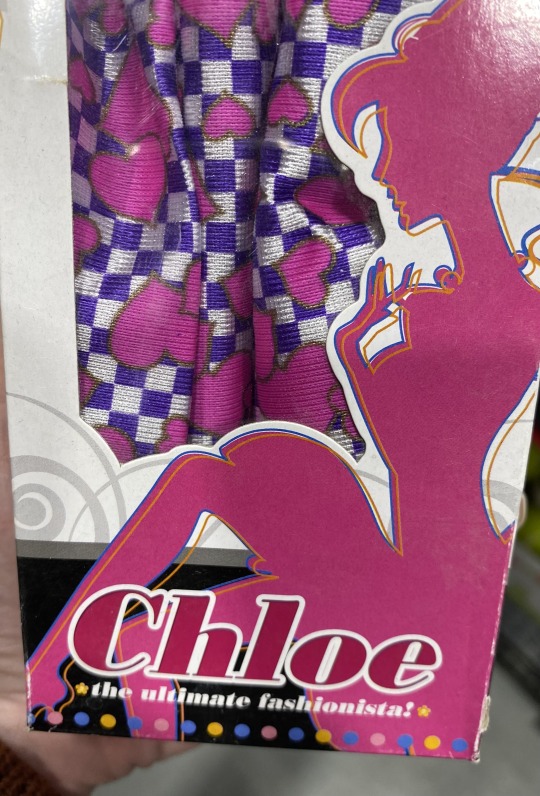
The ultimate in fashion, in Chloe's world, is a kimono.
There was a later gas station, in MacFarland, that had a much smaller toy section, but a different 4.5" mermaid face-up than I've seen before.
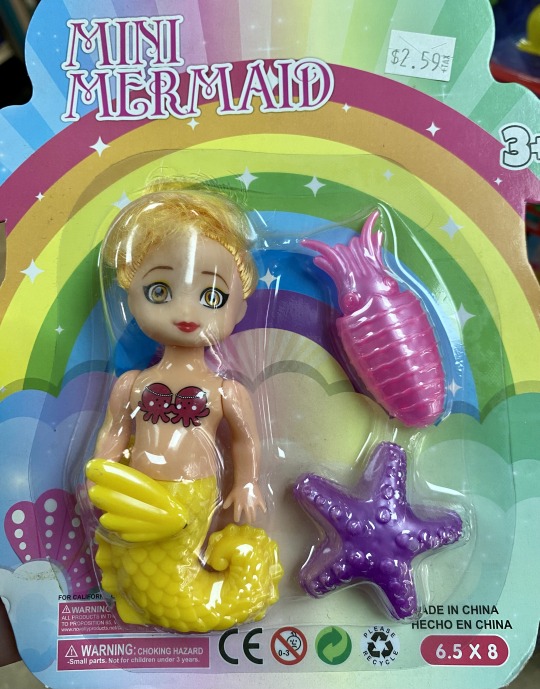
Check out that eye liner! She's genuinely cute -- much cuter than the Dollar Tree mermaid girls -- but her inability to function on land would make her a tough fit with Kelly, Evi Love, and the rest of the 4.5" gang. While I like the face-up, I don't love it enough to get involved with getting her a new body and new hair.
#clone dolls#knock-off dolls#mermaid doll#nurse doll#fashion doll#dollblr#fashion dolls#gas station dolls
2 notes
·
View notes